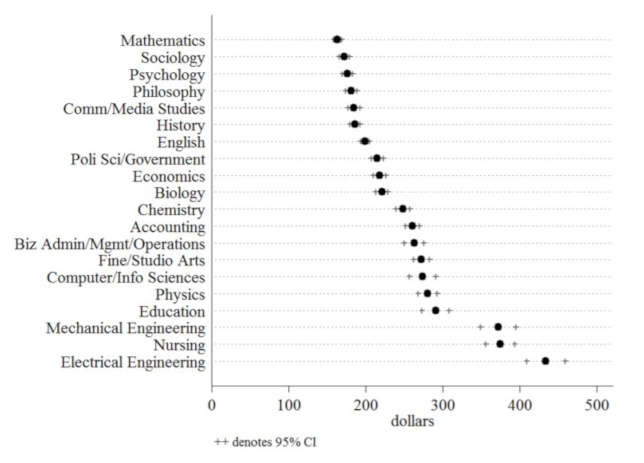Math Field Least Expensive to Teach, Electrical Engineering the Highest
- By Dian Schaffhauser
- 04/15/19
A
new working paper has examined the cost of educating students in
various fields. Apparently, education is more expensive to teach than
just three other subjects: mechanical engineering, nursing and
electrical engineering. Interestingly, even as individual disciplines
may have risen or fallen dramatically in cost, the research project
found that the overall average instructional cost per student credit
hour has "barely budged" over the 15 years of the study
period.
Researchers
from the University
of North Carolina at Chapel Hill,
the University
of Michigan
and the University
of Delaware
used department-level data on the expenditures, outputs and factors
of production for a sizable, diverse sampling of four-year
institutions from 2000 to 2015 to uncover the instructional costs
within institutions. The data came from a compilation maintained at U
Delaware, which, since 1998 has collected program-level data from
more than 700 four-year public and private non-profit higher
education institutions and some 22,000 programs.

A
cross-sectional variation in expenses over different disciplines.Electrical engineering averages more than $475 per student credit
hour, about $300 more than for math.
According
to "Why
Is Math Cheaper than English? Understanding Cost Differences in
Higher Education,"
published by the National
Bureau of Economic Research (NBER),
costs are "generally higher" in disciplines where graduates
earn more and in pre-professional programs.
The
researchers used English as the benchmark. According to the report,
the average English class with 20 students incurred about $12,500 in
instructional expense. Electrical engineering came in 109 percent
higher than that; math was 22 percent lower.
The
researchers could explain most of the variation in costs by examining
the differences in class sizes and faculty pay. Economics was an
example of that. Economics instructors "are more highly paid"
with a lighter workload than English instructors, but those classes
also tend to be "much larger," thereby offsetting the
higher salary and lower workload. An opposite example was mechanical
engineering, where those faculty also earn a higher wage and have
lower teaching loads than English instructors. Yet, the class sizes
are only "modestly larger," resulting in a just a tiny
offset, making mechanical engineering 82 percent more expensive than
English.
Some
STEM fields experienced steep declines in expense over the past 15
years while others rose. The ones that dropped included mechanical
engineering, chemistry, physics, biology and nursing. The researchers
explained those trends by finding large increases in class size (for
mechanical engineering and nursing) and increases in faculty teaching
load (chemistry and biology) as well as a shift to the use of adjunct
faculty.
The
same research found that online instruction was linked with (though
not necessarily caused by) a "modest reduction" in the cost
per student, but only for the largest undergraduate online courses.
In the 20 disciplines studied for the project, almost half (48
percent) of the programs had no online enrollment. Online offerings
tended to be more prevalent in graduate education, the report noted.
The
researchers suggested that additional work needed to be done to
understand the ties between the "inputs" (such variables as
faculty wages and class size) and the outcomes -- student performance
and success after college.
The
working paper is available in digital form on
the NBER website
for a nominal fee.
About the Author
Dian Schaffhauser is a former senior contributing editor for 1105 Media's education publications THE Journal, Campus Technology and Spaces4Learning.